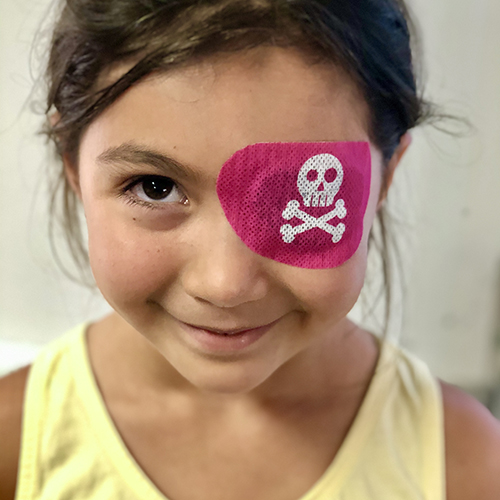
As a mom, Paige Brattin knows one thing for certain: Pirate play aside, wearing an eye patch is no fun. She learned this about five years ago after her daughter Eddy was diagnosed with multiple vision problems, including amblyopia.
Also called lazy eye, amblyopia can happen when the vision in one of a child’s eyes is weaker than the vision in the other. Over time, the brain relies more and more on the “strong” eye, causing the vision in the weak eye to grow worse and worse. It’s the most common cause of vision loss in kids. One standard treatment is for the child to wear a patch over the stronger eye for several hours a day, so that vision in the weaker eye improves. It’s remarkably effective but, again, no fun.
Eddy, who will soon turn 11, started with a patch that slipped over her glasses. That worked well for about a year, but then Eddy started to “cheat” and peek under the patch and had to switch to adhesive patches. That’s where the trouble began. “They, to me, were just antiquated,” says Brattin. “I could not believe the material, the shape, the size, the patterns.” The available patches were decorated with bunnies and teddy bears that Eddy, even as a 6-year-old, declared “uncool.” When Brattin tried contacting the company that made the patches, “They were very proud of their designs and definitely did not want feedback,” she says.
On top of that, the patches didn’t breathe, causing Eddy to sweat and irritating the delicate skin around her eye. “When I started to research it, I realized that this was a huge complaint by every parent, every family, the lack of breathability,” Brattin says.
Working with a product-development company, Brattin set out to build a better patch. She based the shape on aviator sunglasses so they’d be a better fit for kids’ faces, administered adhesive in small strips for less skin irritation, and chose a breathable material. “That trifecta definitely makes for a better-fitting, more-comfortable patch,” she says. “What was on the market hadn’t changed since the ’70s.” She also ditched the teddies and bunnies in favor of designs that boast everything from narwhals to unicorns, tigers, fruit, pizza and pirates. The products, See Worthy, have been on the market since December 2018.
There are even blank See Worthy patches that kids can decorate themselves, and Brattin says some classrooms have used this as a class project so that the child who patches has some decorated by classmates to wear.
Some of the proceeds from See Worthy sales are donated to vision-screening programs, which help ensure children receive the recommended checkups at ages 6 months, 1-2 and 3-4 years, and annually after age 5. Early detection of amblyopia can help save a child’s vision.
Eddy’s vision has improved to what her mom calls “a pretty normal vision impairment,” but she still patches a little each day. Meanwhile, Brattin has turned @see_worthy_patches on Instagram into an unofficial support group where parents post photos and patching tips. “It can be brutal, asking a child to do this every day,” she says, “and it’s just a really supportive community.”

























